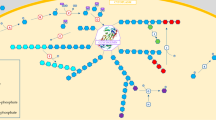Abstract.
Our objective was to evaluate the long-term effects of dietary therapy of type I glycogen storage disease which avoids increased lactate production during childhood and adolescence. In order to suppress hepatic glucose and increased lactate production consistently day and night, the treatment regimen included nocturnal intragastric feeding of glucose polymer during childhood and adolescence. The aim was to keep the blood glucose concentration in the "high normal range" (4.3–5.5 mmol/l) and the lactate concentration in urine in the normal range (<0.06 mol/mol creatinine). The amounts of dietary carbohydrate required decreased in an age-related manner from 11.9±1.3 mg/kg body weight per min by day and 6.9±0.9 mg/kg body weight per min by night at 1 year of age to 5.2±1.0 and 2.9±1.2 mg/kg body weight per min, respectively, at the age of 16 years. In 15 infants, therapy started at 5.8±3.2 months of age and induced catch up growth over 1–2 years by which time the mean height SDS increased from –1.02±0.91 to –0.19±1.07. In the well controlled patients, further growth continued within that range. From 12 years of age, mean height SDS was in line with the respective mean SDS of mid-parental target height. The plasma lipid concentrations were markedly reduced, but were not brought into the normal range. So far, no adolescent showed liver adenoma or renal damage. Four patients with poor metabolic control due to poor compliance with treatment (frequently subnormal plasma glucose concentrations, severe hypoglycaemia, and increased urinary lactate excretion) showed retardation of growth and bone maturation. Conclusion: avoiding increased lactate production by keeping the blood glucose concentration permanently in the "high normal range" seems to be crucial for growth according to the genetic potential.
Similar content being viewed by others
Author information
Authors and Affiliations
Additional information
Electronic Publication
Rights and permissions
About this article
Cite this article
Däublin, G., Schwahn, B. & Wendel, U. Type I glycogen storage disease: favourable outcome on a strict management regimen avoiding increased lactate production during childhood and adolescence. Eur J Pediatr 161 (Suppl 1), S40–S45 (2002). https://doi.org/10.1007/s00431-002-1001-1
Issue Date:
DOI: https://doi.org/10.1007/s00431-002-1001-1




